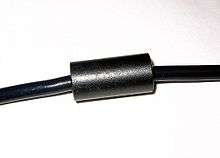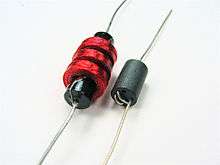Ferrite bead
A ferrite bead or ferrite choke is a passive electric component that suppresses high-frequency noise in electronic circuits. It is a specific type of electronic choke. Ferrite beads employ high-frequency current dissipation in a ferrite ceramic to build high-frequency noise suppression devices. Ferrite beads may also be called blocks, cores, rings, EMI filters, or chokes.[1][2]
Use

Ferrite beads prevent electromagnetic interference (EMI) in two directions: from a device or to a device.[1] A conductive cable acts as an antenna – if the device produces radio-frequency energy, this can be transmitted through the cable, which acts as an unintentional radiator. In this case the bead is required for regulatory compliance, to reduce EMI. Conversely, if there are other sources of EMI, such as household appliances, the bead prevents the cable from acting as an antenna and receiving interference from these other devices. This is particularly common on data cables and on medical equipment.[1]
Large ferrite beads are commonly seen on external cabling. Various smaller ferrite beads are used internally in circuits—on conductors or around the pins of small circuit-board components, such as transistors, connectors and integrated circuits.
On wires intended to be DC conductors, beads can block low level unintended radio frequency energy by acting as a low pass filter. On unbalanced coax transmission lines (for instance, USB cables and video cables) the cable is designed to contain the signal, and beads can be used to block stray common mode current from using the cable as an antenna while not interfering with the signal carried inside the cable. In this use, the bead is a simple form of a balun.
Ferrite beads are one of the simplest and least expensive types of interference filters to install on preexisting electronic cabling. For a simple ferrite ring, the wire is simply wrapped around the core through the center, typically five or seven times. Clamp-on cores are also available, which attach without wrapping the wire: this type of ferrite core is usually designed so that the wire passes only once through it. If the fit is not snug enough, the core can be secured with cable ties or, if the center is large enough, the cabling can loop through one or more times. (Note, however, that although each loop increases the impedance to high frequencies, it also shifts the frequency of the highest impedance to a higher frequency.) Small ferrite beads can be slipped over component leads to suppress parasitic oscillation.[3]
Surface-mount ferrite beads are available. These are soldered into a gap in the printed circuit board trace, just like any other surface-mount inductor. Inside the bead component, a coil of wire runs between layers of ferrite to form a multi-turn inductor around the high-permeability core.[4]
Theory of operation

Ferrite beads are used as a passive low-pass filter, by converting RF energy to heat, by design. (Contrast this with inductors, which by design minimize conversion of RF energy to heat, offering a high impedance to RF.)
The geometry and electromagnetic properties of coiled wire over the ferrite bead result in an impedance for high-frequency signals, attenuating high-frequency EMI/RFI electronic noise. The energy is either reflected back up the cable, or dissipated as low-level heat. Only in extreme cases is the heat noticeable.
A pure inductor does not dissipate energy but it produces reactance that impedes the flow of higher frequency signals. This reactance is commonly referred to simply as impedance, although impedance can be any combination of resistance and reactance.

A ferrite bead can be added to an inductor to improve, in two ways, its ability to block unwanted high frequency noise. First, the ferrite concentrates the magnetic field, increasing inductance and therefore reactance, which impedes or ‘filters out’ the noise. Second, if the ferrite is so designed, it can produce an additional loss in the form of resistance in the ferrite itself. The ferrite creates an inductor with a very low Q factor.[3] This loss heats the ferrite, normally by a negligible amount. While the signal level is large enough to cause interference or undesirable effects in sensitive circuits, the energy blocked is typically quite small. Depending on the application, the resistive loss characteristic of the ferrite may or may not be desired.
A design that uses a ferrite bead to improve noise filtering must take into account specific circuit characteristics and the frequency range to block. Different ferrite materials have different properties with respect to frequency, and manufacturer's literature helps select the most effective material for the frequency range.[3][5] Typically the material used in the beads is powdered ferrite, with the mix of grain sizes adjusted to control the range of frequencies absorbed or blocked and minimize magnetic field storage. Contrast this with inductors and transformers, which use solid or laminated iron or copper cores to store magnetic fields and maximize energy transfer.
See also
References
- Vanhoenacker, Mark (November 1, 2012). "What Is That Little Cylinder on My Computer Wire?". Brow Beat blog. Slate. Retrieved 2012-11-03.
- "What are the bumps at the end of computer cables?". HowStuffWorks. InfoSpace LLC. April 1, 2000. Retrieved 21 April 2015.
- Carr, Joseph J. (2002). RF Components and Circuits. Newnes. pp. 264–266. ISBN 978-0-7506-4844-8.
- Ferrite Bead Inductors – Electronics Notes
- Crowell, Benjamin. "Simple Nature". Retrieved 21 April 2015.
External links
| Wikimedia Commons has media related to Ferrite beads. |